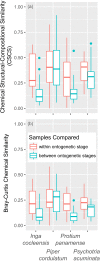A comparison of inducible, ontogenetic, and interspecific sources of variation in the foliar metabolome in tropical trees
- PMID: 31579568
- PMCID: PMC6756142
- DOI: 10.7717/peerj.7536
A comparison of inducible, ontogenetic, and interspecific sources of variation in the foliar metabolome in tropical trees
Abstract
Plant interactions with other organisms are mediated by chemistry, yet chemistry varies among conspecific and within individual plants. The foliar metabolome-the suite of small-molecule metabolites found in the leaf-changes during leaf ontogeny and is influenced by the signaling molecule jasmonic acid. Species differences in secondary metabolites are thought to play an important ecological role by limiting the host ranges of herbivores and pathogens, and hence facilitating competitive coexistence among plant species in species-rich plant communities such as tropical forests. Yet it remains unclear how inducible and ontogenetic variation compare with interspecific variation, particularly in tropical trees. Here, we take advantage of novel methods to assemble mass spectra of all compounds in leaf extracts into molecular networks that quantify their chemical structural similarity in order to compare inducible and ontogenetic chemical variation to among-species variation in species-rich tropical tree genera. We ask (i) whether young and mature leaves differ chemically, (ii) whether jasmonic acid-inducible chemical variation differs between young and mature leaves, and (iii) whether interspecific exceeds intraspecific chemical variation for four species from four hyperdiverse tropical tree genera. We observed significant effects of the jasmonic acid treatment for three of eight combinations of species and ontogenetic stage evaluated. Three of the four species also exhibited large metabolomic differences with leaf ontogenetic stage. The profound effect of leaf ontogenetic stage on the foliar metabolome suggests a qualitative turnover in secondary chemistry with leaf ontogeny. We also quantified foliar metabolomes for 45 congeners of the four focal species. Chemical similarity was much greater within than between species for all four genera, even when within-species comparisons included leaves that differed in age and jasmonic acid treatment. Despite ontogenetic and inducible variation within species, chemical differences among congeneric species may be sufficient to partition niche space with respect to chemical defense.
Keywords: Coexistence; Community ecology; Intraspecific variation; Mass spectrometry; Metabolomics; Plant-herbivore interactions.
©2019 Sedio et al.
Conflict of interest statement
S. Joseph Wright is an Academic Editor for PeerJ.
Figures





References
-
- Boege K. Induced responses in three tropical dry forest plant species - direct and indirect effects on herbivory. Oikos. 2004;107:541–548. doi: 10.1111/j.0030-1299.2004.13272.x. - DOI
LinkOut - more resources
Full Text Sources

